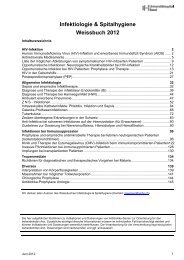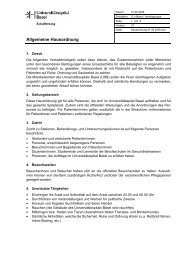Transmucosal Nasal Drug Delivery: Systemic Bioavailability of ...
Transmucosal Nasal Drug Delivery: Systemic Bioavailability of ...
Transmucosal Nasal Drug Delivery: Systemic Bioavailability of ...
Create successful ePaper yourself
Turn your PDF publications into a flip-book with our unique Google optimized e-Paper software.
1. <strong>Nasal</strong> drug delivery<br />
1.4 Nose to brain-transport<br />
The blood-brain barrier provides an efficient diffusion barrier especially for polar drugs. Hence,<br />
limitations are evident in the treatment <strong>of</strong> diseases <strong>of</strong> the central nerve system, such as<br />
Parkinson’s and Alzheimer’s disease. It has been suggested that after intranasal administration,<br />
some drugs reach the targeted brain structures, circumventing the blood-brain barrier. Lipophilic<br />
compounds may be transported by neuronal transport <strong>of</strong> nervus olfactorius. Extend <strong>of</strong> neuronal<br />
transport is highly dependent on the physicochemical properties <strong>of</strong> the drugs, namely the molecular<br />
weight and the lipophilicity [Illum 2004]. The existence <strong>of</strong> the olfactory-pathway has been proven for<br />
some compounds in animal models, but not in human [Illum 2000].<br />
Since central nervous bioavailability <strong>of</strong> drugs, transported by the olfactory-pathway is estimated to<br />
be 0.01% to 0.1%, only very potent drugs may reach therapeutic levels at the central nervous side<br />
<strong>of</strong> action by nose to brain-transport.<br />
Pre-estimating the contribution <strong>of</strong> the olfactory pathway in drug transport to the brain, the<br />
differences between the species in respect to localization and extend <strong>of</strong> the olfactory epithelium<br />
has to be considered. Furthermore, Graff and Pollak suggested efflux transporters to impair drug<br />
concentration in the brain after transmucosal nasal administration [Graff and Pollack 2003].<br />
In human the olfactory epithelium is situated in the superior conchae and therefore hardly<br />
moistened by common nasal sprays. To ensure the delivery <strong>of</strong> a drug to the olfactory epithelium<br />
some authors propose specially developed delivery devices or application techniques [Dhanda et<br />
al., 2005].<br />
Assuming the existence <strong>of</strong> an olfactory-pathway to the brain in human, it remains unclear to what<br />
extent it contributes to central nervous availability <strong>of</strong> a nasally administered drug.<br />
Katja Suter-Zimmermann Page 15 <strong>of</strong> 188 University <strong>of</strong> Basel, 2008

















